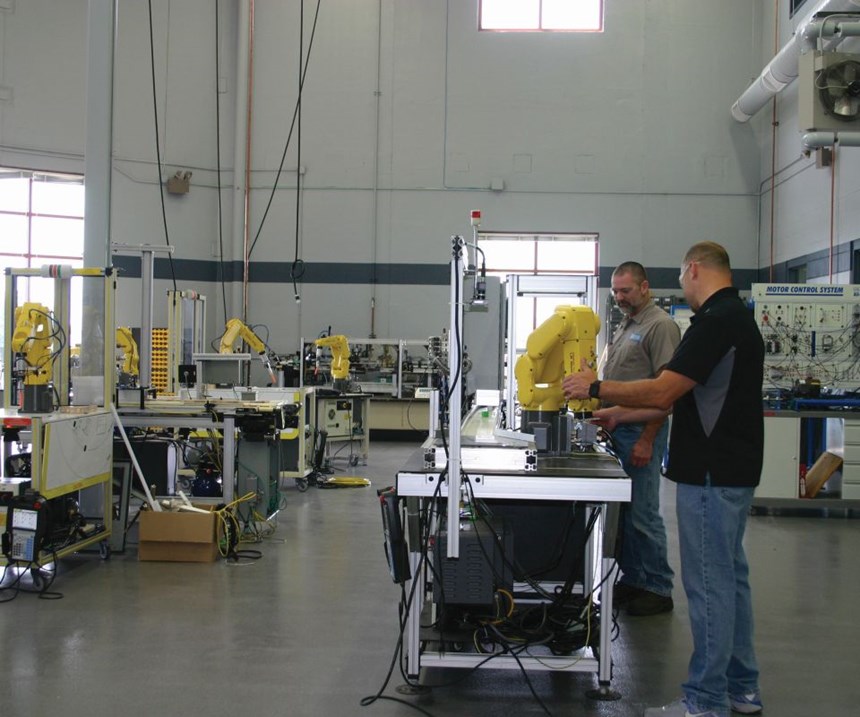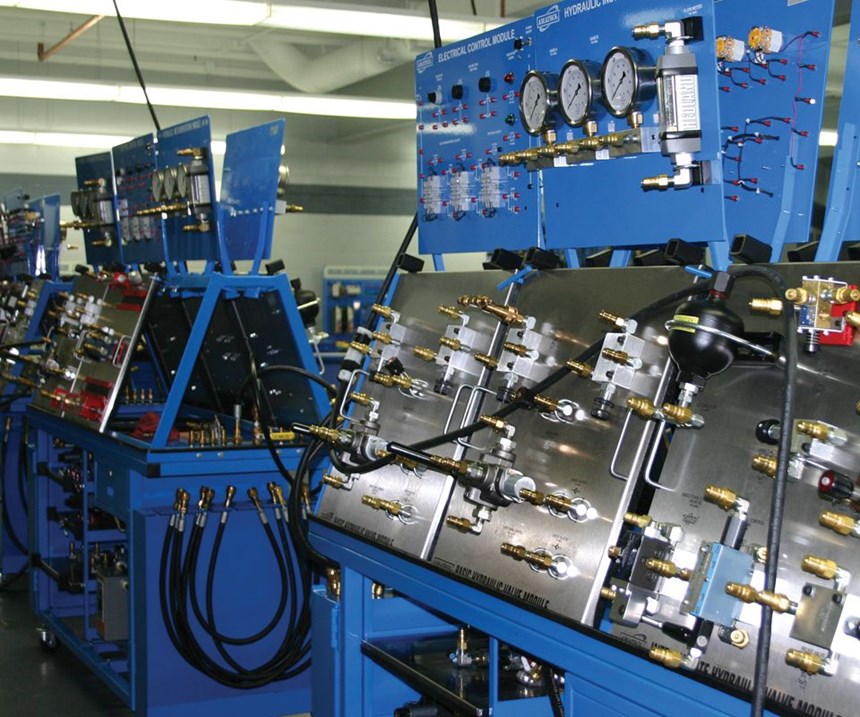Breaking Down the Skills Gap, Part 2
With the skills gap now defined, the next step is implementing strategies to close it.
Last month, we explored the deficiency in the labor market of individuals with the necessary hard and soft skills to make them suitable employees for manufacturers. This skills gap has been caused by the unpopularity of manufacturing as a career choice, the perception that manufacturing jobs are relatively less secure than other fields and the lack of student exposure to manufacturing. All of these factors have left employers finding it increasingly difficult to secure the requisite talent to grow their organizations and to compete in the global economy.
However, there still exists reason for optimism. There are grassroots efforts led by industrial employers, educators and solutions providers who are partnering in innovative ways to educate young people about the rewarding careers that await them in the manufacturing sector, while exposing them to the environments and skills that nurture an interest in industry. Here, we will examine the reasons for optimism and a potential path forward if we are able to close the skills gap.
Proceed with Enthusiasm and Caution
In addition to his role as the president of Amatrol Inc., a skills-based, interactive technical learning provider in Jeffersonville, Indiana, Paul Perkins serves as chair of the State Workforce Innovation Council and on the National Association of State Workforce Board Chairs. Perkins’ view of manufacturing’s future in the United States is one of enthusiastic yet cautious optimism.
“There have been changes in the manufacturing economy that I believe foretell a very bright future for manufacturing in the U.S.,” he says. “People are seeing that the U.S. has a lot of things going for it, including the rule of law, low-cost energy, infrastructure and intellectual property protection. U.S. manufacturing has a bright future, but finding the workforce will be its biggest challenge.”
That challenge, however, evades a simple or easy fix, and addressing it will require a holistic approach to workforce development. Let’s take a look at a few strategies and efforts underway:
Exposure, not slogans. As the education director of manufacturing for the 16 colleges that comprise the Wisconsin Technical College System (WTCS), Jim Mackey has a good idea of what does and doesn’t work. “I hear people say we need to ‘advertise,’ and then they put out a poster,” Mackey says. “That’s not going to work. We need to have exposure, not slogans.”
Exposure, according to Mackey, can take a number of forms, ranging from organized tours of local manufacturing facilities, manufacturing labs located in high schools and middle schools, manufacturing-related school clubs, and summer camps that expose young people to manufacturing career pathways about which they may not be aware.
Hands-on learning. Perkins agrees. “A large percentage of students do not choose to go into STEM (science, technology, engineering and math) careers because their parents are not in a STEM career and they do not know anyone who works in one,” he says. “We have to find ways for youth and parents to see what modern manufacturing looks like.” This entails authentic, hands-on, experiential learning that goes beyond what most high schools and middle schools currently include in their curricula.
FANUC, a supplier of robotic automation and computer numeric controls (CNCs), is providing advanced manufacturing training by offering educational access to the same robots, teach pendants and CNCs that students will encounter in industry. The company expects to engage the minds of learners while simultaneously building hands-on industrial skills.
“As students work with the latest in software and robotics and are having fun, they will talk to their parents about it, and by the time they get to high school, we have influenced a career decision,” says Mike Cicco, FANUC America’s president and CEO.
FANUC and Amatrol are just two examples of the many companies using authentic industrial skills training to help students build the skills needed for welding, injection molding, toolmaking, fluid power, electronics, programmable logic controller operation, heavy equipment operation, industrial painting and more.
Incumbent worker training. Although many initiatives are aimed at changing the hearts and minds of young people, there also needs to be a focus on the people already in the workforce in the form of incumbent industrial worker training and portability of talent from non-industrial employment sectors into manufacturing.
Thanks in part to his work at the national level, Perkins has gained an interesting perspective. He points out that, 20 years from now, 70 percent of the workforce will be comprised of people who are already working today. For this reason, he believes that manufacturers should provide continuous training to give current employees the skills required to move them into the next job on the ladder. Since the current employer is already familiar with the employee’s work ethic and character, this will be preferable to hiring someone from the outside.
This incumbent worker training is gaining traction through the variety of available efficient, cost-effective online learning tools. For example, Amatrol’s eLearning platform provides more than 300 courses and several thousand hours of online content related to a wide range of industrial skills. In addition to adopting this technology individually, employers can choose to partner with a local technical or community college to deliver the appropriate combination of virtual and hands-on instruction.
Often this learning can be delivered in pursuit of industrial credentials, such as CNC and industrial technology maintenance certifications from the National Institute for Metalworking Skills (NIMS), and FANUC’s Certified Education Robot Training program. “One of the big things that is occurring is a much stronger focus on competencies,” Perkins says. “These competencies are best represented by industry credentials.”
Technical and community colleges. As these institutions establish flexible learning models, they will also play a crucial role in preparing the talent necessary to fill the skills gap. Take, for example, WTCS’ mobile labs. Each technical college in the state received funding to invest in a tractor-trailer packed full of learning opportunities in disciplines such as robotics, CNC, welding and factory automation. Not only can these mobile labs be used to reach manufacturing employers at their own facilities, many colleges are integrating them into the curricula of the high schools located in the regions they serve, in effect, becoming part of each high school’s technical education lesson plans.
Another innovative educational tool is the dual credit, whereby students can take courses in high school that count for college credit once they reach technical college. “Dual credit, especially if it’s transcripted (immediate credit), is a way of getting high school students started early and giving them some exposure to what’s available at the local technical college,” Mackey says.
The Path Forward
Can the skills gap be closed? The answer is yes, but only through a broad strategy that includes:
• Winning the interest of young people.
• Providing authentic manufacturing learning models at an early age.
• Modifying the approach to technical education to reach a wider range of young and adult learners.
• Using a flexible learning model that accommodates traditional students but also adapts to the complex schedules of those already in the workforce.
Manufacturers, too, must become part of the solution. They need to open their doors to influence the career choices of young people, familiarize themselves with industry credentials, get involved in local technical colleges and commit to providing a higher level of incumbent employee training through technology.
Today, U.S. manufacturing is being aided by a tailwind fueled by innovation and advancements in industrial technology, making the future of domestic manufacturing optimistic—if we come together to close the skills gap. As Perkins says: “If we don’t fix that problem, someone else will.”
Related Content
The Role of Social Media in Manufacturing
Charles Daniels CFO of Wepco Plastics shares insights on the role of social media in manufacturing, how to improve the “business” side of a small mold shop and continually developing culture.
Read MoreTackling a Mold Designer Shortage
Survey findings reveal a shortage of skilled mold designers and engineers in the moldmaking community, calling for intervention through educational programs and exploration of training alternatives while seeking input from those who have addressed the issue successfully.
Read MoreCross Training, In-House Capabilities and Collaborative Design Move Helm Tool Forward
Cross-training, bringing it all in-house, molding and collaborative design are essential to Helm Tool's success.
Read MoreConfronting the Mold Design Talent Drought
Recently, I reposted on LinkedIn the results of an informal survey we conducted, which revealed a shortage of skilled mold designers. It quickly gained a lot of traction. Given the response, I thought I'd summarize the feedback and keep the conversation going.
Read MoreRead Next
How to Use Strategic Planning Tools, Data to Manage the Human Side of Business
Q&A with Marion Wells, MMT EAB member and founder of Human Asset Management.
Read MoreHow to Use Continuing Education to Remain Competitive in Moldmaking
Continued training helps moldmakers make tooling decisions and properly use the latest cutting tool to efficiently machine high-quality molds.
Read MoreReasons to Use Fiber Lasers for Mold Cleaning
Fiber lasers offer a simplicity, speed, control and portability, minimizing mold cleaning risks.
Read More




























